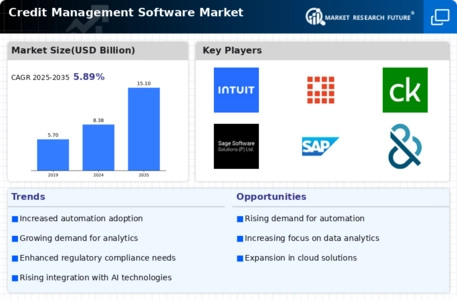The credit management software market has experienced significant growth due to the increasing need for organizations to optimize their cash flow, manage credit risk, and streamline their collections process.
This market is characterized by a wide range of software solutions that cater to diverse business needs, from small enterprises to large corporations. Competition in this landscape is fierce, with various key players constantly innovating and improving their offerings.
The demand for efficient credit management tools is driven by the need for businesses to enhance their financial management capabilities in a rapidly changing economic environment.
As organizations prioritize financial stability, the integration of advanced technologies such as artificial intelligence and real-time data analytics into credit management solutions has become critical, positioning established players and new entrants to capitalize on evolving customer requirements.
Intuit has established a formidable presence in the credit management software market by offering a suite of robust financial solutions tailored to the needs of small and medium-sized enterprises. The company provides innovative tools that effectively manage invoicing, payment collection, and credit scoring.
Intuit's strengths lie in its user-friendly interface and comprehensive support, which empower businesses to monitor their financial health efficiently. Leveraging its extensive experience in accounting and financial software, Intuit has successfully integrated credit management features that assist users in understanding their credit profiles and making informed decisions.
Furthermore, Intuit's strong commitment to customer service and ongoing product enhancements enables it to maintain customer loyalty and attract new users in a competitive landscape.
FICO is another key player in the credit management software market that has garnered respect for its advanced analytical tools and credit risk management capabilities. The company specializes in providing sophisticated software solutions that not only automate credit decision-making processes but also enhance the overall effectiveness of credit operations.
FICO's strengths include its expertise in data analytics and machine learning, which allow organizations to accurately assess creditworthiness and optimize their credit policies. Moreover, FICO has developed strong partnerships and collaborations within the industry, further solidifying its market presence.
By continuously evolving its offerings and integrating innovative technologies into its software solutions, FICO is well-positioned to meet the growing demands of businesses seeking to refine their credit management practices.

























Leave a Comment